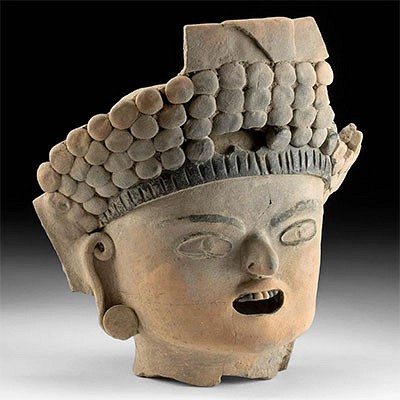Classical Phoenician Black Jasper Scarab, Horse & Rider
Lot 91
About Seller
Artemis Fine Arts
686 S Taylor Ave, Ste 106
Louisville, CO 80027
United States
Selling antiquities, ancient and ethnographic art online since 1993, Artemis Gallery specializes in Classical Antiquities (Egyptian, Greek, Roman, Near Eastern), Asian, Pre-Columbian, African / Tribal / Oceanographic art. Our extensive inventory includes pottery, stone, metal, wood, glass and textil...Read more
Estimate:
$1,400 - $2,100
Absentee vs Live bid
Two ways to bid:
- Leave a max absentee bid and the platform will bid on your behalf up to your maximum bid during the live auction.
- Bid live during the auction and your bids will be submitted real-time to the auctioneer.
Bid Increments
| Price | Bid Increment |
|---|---|
| $0 | $25 |
| $300 | $50 |
| $1,000 | $100 |
| $2,000 | $250 |
| $5,000 | $500 |
| $10,000 | $1,000 |
| $20,000 | $2,500 |
| $50,000 | $5,000 |
| $100,000 | $10,000 |
| $200,000 | $20,000 |
About Auction
By Artemis Fine Arts
May 18, 2023
Set Reminder
2023-05-18 10:00:00
2023-05-18 10:00:00
America/New_York
Bidsquare
Bidsquare : Ancient | Asian | Ethnographic Art
https://www.bidsquare.com/auctions/artemis-gallery/ancient-asian-ethnographic-art-12797
Featuring classical antiquities, ancient, and ethnographic art from cultures encompassing the globe. Egyptian, Greek, Roman, Near Eastern, Asian, Pre-Columbian, Native American, African / Tribal, Oceanic, Spanish Colonial, Fossils, more! All legally acquired, legal to sell. Satisfaction guaranteed. Artemis Fine Arts info@artemisgallery.com
Featuring classical antiquities, ancient, and ethnographic art from cultures encompassing the globe. Egyptian, Greek, Roman, Near Eastern, Asian, Pre-Columbian, Native American, African / Tribal, Oceanic, Spanish Colonial, Fossils, more! All legally acquired, legal to sell. Satisfaction guaranteed. Artemis Fine Arts info@artemisgallery.com
- Lot Description
**First Time At Auction**
Ancient Near East, Achaemenid Persian Empire, Classical Phoenician / Greco-Phoenician, ca. 539 to 332 BCE. A rare black jasper stamp seal in the form of a scarab with the image of a man riding a horse incised onto the base and a lateral drill hole for suspension. Naturalistically rendered, the ancient insect displays smooth wings, a notched thorax, a striped clypeus, and feathered front legs. The horseman rides right and either raises an arm or holds a spear, while the horse presents a thick body atop slender legs with a prominent, crested mane and a lengthy tail that extends from his round posterior. Classical Phoenician scarabs were made in Phoenicia in the period of the Achaemenid Persian empire. Aside from the Etruscans, they are the last major production of scarab seals in antiquity. Size: 0.6" L x 0.5" W (1.5 cm x 1.3 cm)
Phoenician subjects of their intaglios are the most eclectic of any medium of the period, and are sorted into the categories of Egyptianizing, Levantine, and Hellenizing. Though not as common on Greek scarabs, this horseman would be considered a Hellenizing subject.
For similar examples, please see section 27 "Horsemen" in "Classical Phoenician Scarabs: A Catalogue and Study" by John Boardman (Oxford England: Archaeopress, 2003).
Provenance: East Coast collection, New York Gallery, New York City, New York, USA, acquired before 2010
All items legal to buy/sell under U.S. Statute covering cultural patrimony Code 2600, CHAPTER 14, and are guaranteed to be as described or your money back.
A Certificate of Authenticity will accompany all winning bids.
We ship worldwide and handle all shipping in-house for your convenience.
#178714Some light surface wear with minor nicks to periphery as shown, but form and imagery are clear. Otherwise, intact and excellent with nice remaining detail and light earthen deposits in recessed areas. Wearable as a bead or pendant.Condition
- Shipping Info
-
All shipping is handled in-house for your convenience. Your invoice from Artemis Gallery will include shipping calculation instructions. If in doubt, please inquire BEFORE bidding for estimated shipping costs for individual items.
-
- Buyer's Premium



 EUR
EUR CAD
CAD AUD
AUD GBP
GBP MXN
MXN HKD
HKD CNY
CNY MYR
MYR SEK
SEK SGD
SGD CHF
CHF THB
THB














